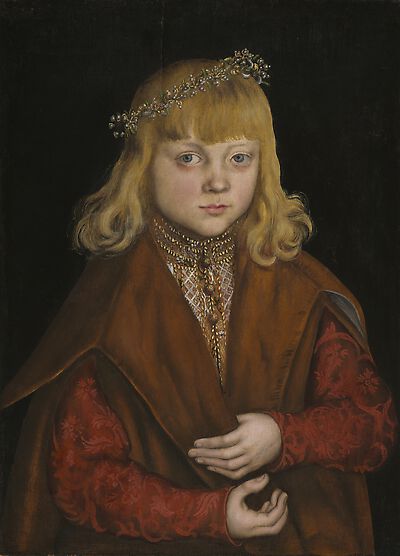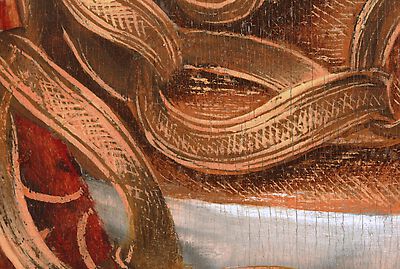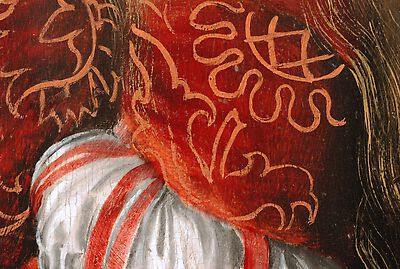| Sandner, Heydenreich, Smith-Contini 2015 |
129, Fn. 7 |
|
|
|
|
| Nuechterlein 2011 |
5-6 |
|
Fig. 6 |
| Author | Jeanne Nuechterlein |
|---|
| Title | Translating Nature Into Art: Holbein, The Reformation, and Renaissance Rhetoric |
|---|
| Place of Publication | University Park, Pennsylvania |
|---|
| Year of Publication | 2011 |
|---|
|
| Exhib. Cat. Rome 2010 |
176 - 178 |
No. 15 |
Pl. p. 177 |
| Editor | Galleria Borghese, Rome, Anna Coliva, Bernard Aikema |
|---|
| Title | Cranach. L'altro rinascimento / a different renaissance, [Rome, Galleria Borghese 15 ottobre 2010 - 13 febbraio 2011] |
|---|
| Place of Publication | Milan |
|---|
| Year of Publication | 2010 |
|---|
|
| Exhib. Cat. Frankfurt 2007 |
258-260 |
69 |
p. 259 |
| Editor | Bodo Brinkmann |
|---|
| Title | Cranach der Ältere, [Frankfurt, Städel Museum, 23 Nov 2007 - 17 Feb 2008] |
|---|
| Place of Publication | Ostfildern |
|---|
| Year of Publication | 2007 |
|---|
|
| Hand 2004 |
138 |
No. 104 |
Fig. |
| Author | John Oliver Hand |
|---|
| Title | National Gallery of Art. Master Paintings from the Collection. |
|---|
| Place of Publication | Washington, New York |
|---|
| Year of Publication | 2004 |
|---|
|
| Southgate 2001 |
88-89 |
|
Fig. |
| Author | M. Therese Southgate |
|---|
| Title | The Art of JAMA II: Covers and Essays from The Journal of the American Medical Association |
|---|
| Place of Publication | Chicago |
|---|
| Year of Publication | 2001 |
|---|
|
| Beckett 1999 |
20 |
|
Fig. |
| Author | Wendy Beckett |
|---|
| Title | My Favorite Things. 75 Works of Art from Around the World. |
|---|
| Place of Publication | New York |
|---|
| Year of Publication | 1999 |
|---|
|
| Löcher 1995 A |
15 |
|
|
| Author | Kurt Löcher |
|---|
| Title | Review of 'German Paintings of the Fifteenth through Seventeenth Centuries', by John Oliver Hand with the assistance of Sally E. Mansfield |
|---|
| Journal | Kunstchronik |
|---|
| Issue | 43/1 (January 1995) |
|---|
| Year of Publication | 1995 |
|---|
|
| Washington Art Gallery 1994 |
unpaginated |
|
Fig. |
| Author | n. a. |
|---|
| Title | New Publications |
|---|
| Journal | Circle Bulletin |
|---|
| Issue | 11 (Spring 1994) |
|---|
| Year of Publication | 1994 |
|---|
|
| Cat. Washington 1993 |
27-31 |
|
Fig. p. 29 |
| Author | John Oliver Hand, Sally E. Mansfield |
|---|
| Title | German Paintings of the Fifteenth through Seventeenth Centuries |
|---|
| Place of Publication | Washington |
|---|
| Year of Publication | 1993 |
|---|
|
| Southworth 1989 |
9 |
|
Fig. cover |
| Author | M. Therese Southworth |
|---|
| Title | The Cover |
|---|
| Journal | Journal of the American Medical Association |
|---|
| Issue | 262, no. 2 (July 14, 1989) |
|---|
| Year of Publication | 1989 |
|---|
|
| Cat. Washington 1985 |
104 |
|
Fig. |
| Title | European Paintings. An Illustrated Catalogue |
|---|
| Place of Publication | Washington |
|---|
| Year of Publication | 1985 |
|---|
|
| Snyders 1985 |
374, 375 |
|
Fig. 440 |
| Author | James Snyder |
|---|
| Title | Northern renaissance Art. Painting, Sculpture and the Graphic Arts from 1350-1575 |
|---|
| Place of Publication | New York |
|---|
| Issue | First edition |
|---|
| Year of Publication | 1985 |
|---|
|
| Cat. Washington 1984 |
165 |
No. 180 |
Fig. |
| Author | John Walker |
|---|
| Title | National Gallery of Art, Washington, D.C. |
|---|
| Place of Publication | New York |
|---|
| Year of Publication | 1984 |
|---|
|
| Friedländer, Rosenberg 1979 |
|
No. 124 |
|
| Author | Max J. Friedländer, Jakob Rosenberg |
|---|
| Editor | G. Schwartz |
|---|
| Title | Die Gemälde von Lucas Cranach |
|---|
| Place of Publication | Basel, Boston, Stuttgart |
|---|
| Year of Publication | 1979 |
|---|
|
| King 1978 |
33-34 |
|
Plate 13 |
| Author | Marian King |
|---|
| Title | Adventures in Art: National Gallery of Art, Washington, D.C. |
|---|
| Place of Publication | New York |
|---|
| Year of Publication | 1978 |
|---|
|
| CDA.Cat. Washington 1975 A |
165 |
No. 186 |
Fig. p. 164 |
| Author | John Walker |
|---|
| Title | National Gallery of Art, Washington |
|---|
| Place of Publication | New York |
|---|
| Year of Publication | 1975 |
|---|
|
| CDA.Cat. Washington 1975 B |
86 |
|
Fig. p. 87 |
| Author | n. a. |
|---|
| Title | European Paintings: An Illustrated Summary Catalogue |
|---|
| Place of Publication | Washington |
|---|
| Year of Publication | 1975 |
|---|
|
| Koepplin 1974 A |
29, 34, Fn. 47 |
|
|
| Author | Dieter Koepplin |
|---|
| Title | Zwei Fürstenbildnisse Cranachs von 1509 |
|---|
| Journal | Pantheon |
|---|
| Issue | 32 |
|---|
| Year of Publication | 1974 |
|---|
| Pages | 25-34 |
|---|
|
| CDA.Cat. Washingtion 1968 |
27 |
No. 897 |
Fig. |
| Author | n. a. |
|---|
| Title | European Paintings and Sculpture: Illustrations (Companion to the Summary Catalogue, 1965) |
|---|
| Place of Publication | Washington |
|---|
| Year of Publication | 1968 |
|---|
|
| CDA.Cairns, Huntington, Walker 1966 |
114 (vol. 1) |
|
Fig. 115 |
| Editor | Cairns, Huntington, John Walker |
|---|
| Title | A Pageant of Painting from the National Gallery of Art |
|---|
| Volume | 1, 2 |
|---|
| Place of Publication | New York |
|---|
| Year of Publication | 1966 |
|---|
|
| Cat. Washington 1965 |
33 |
|
|
| Author | n. a. |
|---|
| Title | Summary Catalogue of European Paintings and Sculpture |
|---|
| Place of Publication | Washington |
|---|
| Year of Publication | 1965 |
|---|
|
| Werl 1965 |
31-35 |
|
Fig. |
| Author | E. Werl |
|---|
| Title | Herzogin Elisabeth von Sachsen, die Schwester Landgraf Philipps von Hessen in bildlischer Darstellung. Zur Identifizierung von Cranachbildnissen. Landgraf Phillips von Hessen Kinderbild? |
|---|
| Journal | Hessisches Jahrbuch für Landesgeschichte |
|---|
| Issue | 15 |
|---|
| Year of Publication | 1965 |
|---|
| Pages | 23-37 |
|---|
|
| Cat. Washington 1963 |
306 |
|
Fig. |
| Author | John Walker |
|---|
| Title | National Gallery of Art, Washington, D.C. |
|---|
| Place of Publication | New York |
|---|
| Year of Publication | 1963 |
|---|
|
| Ruhmer 1963 |
87 |
No. 17 |
Fig. |
| Author | Eberhard Ruhmer |
|---|
| Title | Cranach |
|---|
| Place of Publication | Cologne |
|---|
| Year of Publication | 1963 |
|---|
|
| Broadley 1960 |
28-29 |
|
Fig. |
| Author | Hugh T. Broadley |
|---|
| Title | German Painting in the National Gallery of Art (Booklet no. 9 in Ten Schools of Painting in the National Gallery of Art, Washington, DC) |
|---|
| Volume | 9 |
|---|
| Place of Publication | Washington |
|---|
| Year of Publication | 1960 |
|---|
|
| Booth Collection 1949 |
71, 75 |
|
Fig. |
| Author | n. a. |
|---|
| Title | Ralph and Mary Booth Bequest in der National Gallery of Art |
|---|
| Journal | Phoebus |
|---|
| Issue | 2, No. 2 (1949) |
|---|
| Year of Publication | 1949 |
|---|
|
| Roggeveen 1949 |
340 |
|
Fig. 338 |
| Author | L. J. Roggeveen |
|---|
| Title | De National Gallery of Art te Washington. |
|---|
| Journal | Phoenix |
|---|
| Issue | 4, no. 12 (December 1949) |
|---|
| Year of Publication | 1949 |
|---|
|
| Booth Collection 1948 A |
40 |
|
Fig. |
| Author | n. a. |
|---|
| Title | Gifts from the Booth Collection |
|---|
| Journal | Connoisseur |
|---|
| Issue | 122 (1948) |
|---|
| Year of Publication | 1948 |
|---|
|
| Booth Collection 1948 B |
C7 |
|
Fig. |
| Author | n. a. |
|---|
| Title | News of Art and Artists |
|---|
| Journal | The Sunday Star |
|---|
| Issue | (February 1, 1948) |
|---|
| Year of Publication | 1948 |
|---|
|
| Booth Collection 1948 C |
unpaginated |
|
Fig. |
| Author | n. a. |
|---|
| Title | Recent Additions to the Ralph and Mary Booth Collection |
|---|
| Place of Publication | Washington |
|---|
| Year of Publication | 1948 |
|---|
|
| Louchheim 1948 |
56-57 |
|
Fig. |
| Author | Aline B. Louchheim |
|---|
| Title | Children Should Be Seen |
|---|
| Journal | Art News Annual |
|---|
| Issue | 46 (1948) |
|---|
| Year of Publication | 1948 |
|---|
|
| Posse 1943 |
57 |
No. 46 |
Fig. |
| Author | Hans Posse |
|---|
| Title | Lucas Cranach d. Ä. |
|---|
| Place of Publication | Vienna |
|---|
| Issue | Second edition |
|---|
| Year of Publication | 1943 |
|---|
|
| Craven 1939 |
261, 261 |
|
Plate 62 |
| Author | Thomas Craven |
|---|
| Title | A Treasury of Art Masterpieces from the Renaissance to the Present Day |
|---|
| Place of Publication | New York |
|---|
| Year of Publication | 1939 |
|---|
|
| Vaughan 1939 |
10-11 |
|
|
| Author | Malcolm Vaughan |
|---|
| Title | Old masters at the fair |
|---|
| Journal | Parnassus |
|---|
| Issue | 11 |
|---|
| Year of Publication | 1939 |
|---|
| Pages | 5-13 |
|---|
|
| Exhib. Cat. Cambridge, Mass. 1936 |
37 |
091 |
Plate 19 |
| Author | Charles L. Kuhn |
|---|
| Editor | Germanic Museum, Cambridge, Mass. |
|---|
| Title | Catalogue of the Germanic Museum exhibition of German paintings of the fifteenth and sixteenth centuries. Lent from American collections |
|---|
| Place of Publication | Cambridge Mass. |
|---|
| Year of Publication | 1936 |
|---|
|
| Kuhn 1936 |
37 |
091 |
pl. XIX |
| Author | Charles L. Kuhn |
|---|
| Title | A Catalogue of German Paintings of the Middle Ages and Renaissance in American Collections |
|---|
| Place of Publication | Cambridge Mass. |
|---|
| Year of Publication | 1936 |
|---|
|
| Frankfurter 1933 A |
|
|
Fig. 19 |
| Author | Alfred M. Frankfurter |
|---|
| Title | Art in the Century of Progress |
|---|
| Journal | The Fine Arts |
|---|
| Issue | 20, no. 2 (June 1933) |
|---|
| Year of Publication | 1933 |
|---|
|
| Friedländer, Rosenberg 1932 |
50 |
105 |
|
|
|
| Washington Art Gallery 1929 B |
196 |
|
Fig. p. 199 |
| Author | n. a. |
|---|
| Title | Illustrierte Berichte: New York. |
|---|
| Journal | Pantheon |
|---|
| Issue | 3 (1929) |
|---|
| Year of Publication | 1929 |
|---|
|
| Exhib. Cat. Detroit 1926 |
|
17 |
|
| Editor | Detroit Institute of Arts |
|---|
| Title | The third loan exhibition of old masters: Italian, Flemish, Dutch, German, French, Spanish and English, fifteenth to nineteenth century [Detroit, Institute of Arts] |
|---|
| Place of Publication | Detroit |
|---|
| Year of Publication | 1926 |
|---|
|























